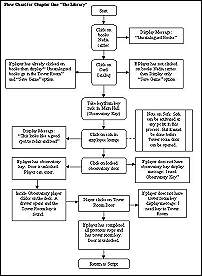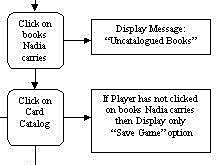 |
||||||||||
|
|
Writing a script for a video game There are two components to writing a script for a video game.There is a Flowchart that lays out the decision making of the game and shows the various logical paths the user can take and there is the prose script that describes what happens. Let me show you a small example of each. I have written the script for a video game called "The Book of the Dead"..
Writing the Flowchart Here is an example of the flowchart that lays out the decision making for part of the first chapter:
Let's take a closer look at the flowchart:
The flowchart helps the designer understand what happens in the game and what decisions need to be made. See the box in the upper left? "Click on Books Nadia carries" A Message is displayed "Uncatalogued Books" The next action available is "Click on Card Catalogue" From here several more options are available. There is a standard for making flow charts complete with rules for decision making and different kinds of boxes for the different kinds of information. You can just make up your own flow chart. But if you want to learn more there are some great books on the subject of flowcharting. Writing the script The script for a video game is very similar to that of a movie. You describe the scenes, plan the dialogue, describe the mood and set the background music. Here is an example of the script from the video game "The Book of the Dead.".Go to sample page for script There are three main points to the written script. 1. Describe the environment; what does everything look like -and what does it feel like? "Opening Scene: Aerial long shot,
dusk 2. What is the accompanying material? Is there music? Sound effects? "Soft background music starts at the moment we see Nadia. ("Chopin's Piano Concerto #2")" "Writers note: We will refer
to Chopin's Piano Concerto #2 as Nadia's theme." 3. What are the things that are going to happen? What decisions will be made? What rooms or areas are the decisions tied to? "This chapter allows the player to get familiar with the library and how the game operates.Goal to completing Chapter: Shelf the uncatalogued books in the Tower Room Programmers notes:There
are five important rooms in this chapter: Important Items in this chapter: Video Game Writing Resources
Video Game Storytelling: What Every Developer Needs to Know about Narrative Techniques With increasingly sophisticated video games being consumed by an enthusiastic and expanding audience, the pressure is on game developers like never before to deliver exciting stories and engaging characters. With Video Game Storytelling , game writer and producer Evan Skolnick provides a comprehensive yet easy-to-follow guide to storytelling basics and how they can be applied at every stage of the development process-by all members of the team. This clear, concise reference pairs relevant examples from top games and other media with a breakdown of the key roles in game development, showing how a team's shared understanding and application of core storytelling principles can deepen the player experience. Understanding story and why it matters is no longer just for writers or narrative designers. From team leadership to game design and beyond, Skolnick reveals how each member of the development team can do his or her part to help produce gripping, truly memorable narratives that will enhance gameplay and bring today's savvy gamers back time and time again.
Professional Techniques for Video Game Writing
Writing for Video Games
. Authors are top game designers There are other books about creating video games out there. Sure, they cover the basics. But The Ultimate Guide to Video Game Writing and Design goes way beyond the basics. The authors, top game designers, focus on creating games that are an involving, emotional experience for the gamer. Topics include integrating story into the game, writing the game script, putting together the game bible, creating the design document, and working on original intellectual property versus working with licenses. Finally, there's complete information on how to present a visionary new idea to developers and publishers. Got game? Get The Ultimate Guide to Video Game Writing and Design. Writing for Video Game Genres: From FPS to RPG
|
|||||||||
Copyright©2001-2016 Kalif Publishing - Contact, copyright and Disclaimer - Let's Make Something T - Storm the Castle T Publishing
|
||||||||||









